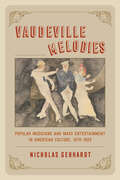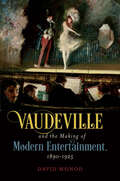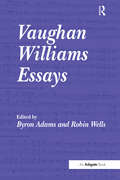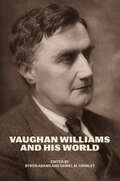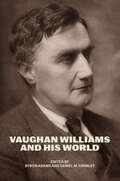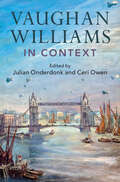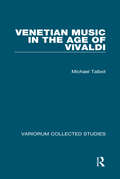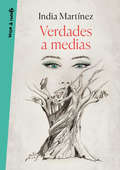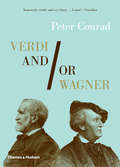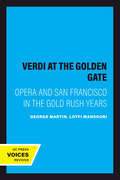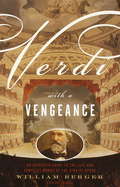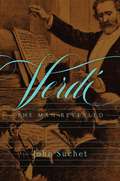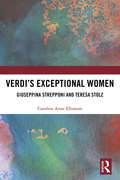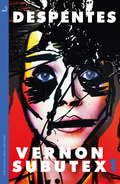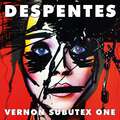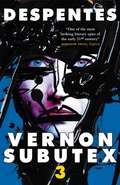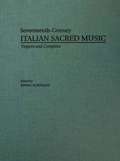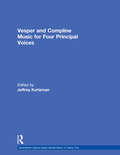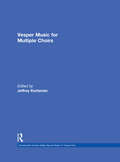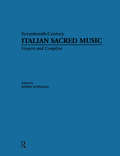- Table View
- List View
Vaudeville Melodies: Popular Musicians and Mass Entertainment in American Culture, 1870-1929
by Nicholas GebhardtIf you enjoy popular music and culture today, you have vaudeville to thank. From the 1870s until the 1920s, vaudeville was the dominant context for popular entertainment in the United States, laying the groundwork for the music industry we know today. In Vaudeville Melodies, Nicholas Gebhardt introduces us to the performers, managers, and audiences who turned disjointed variety show acts into a phenomenally successful business. First introduced in the late nineteenth century, by 1915 vaudeville was being performed across the globe, incorporating thousands of performers from every branch of show business. Its astronomical success relied on a huge network of theatres, each part of a circuit and administered from centralized booking offices. Gebhardt shows us how vaudeville transformed relationships among performers, managers, and audiences, and argues that these changes affected popular music culture in ways we are still seeing today. Drawing on firsthand accounts, Gebhardt explores the practices by which vaudeville performers came to understand what it meant to entertain an audience, the conditions in which they worked, the institutions they relied upon, and the values they imagined were essential to their success.
Vaudeville and the Making of Modern Entertainment, 1890–1925
by David MonodToday, vaudeville is imagined as a parade of slapstick comedians, blackface shouters, coyly revealed knees, and second-rate acrobats. But vaudeville was also America's most popular commercial amusement from the mid-1890s to the First World War; at its peak, 5 million Americans attended vaudeville shows every week. Telling the story of this pioneering art form's rise and decline, David Monod looks through the apparent carnival of vaudeville performance and asks: what made the theater so popular and transformative? Although he acknowledges its quirkiness, Monod makes the case that vaudeville became so popular because it offered audiences a guide to a modern urban lifestyle. Vaudeville acts celebrated sharp city styles and denigrated old-fashioned habits, showcased new music and dance moves, and promulgated a deeply influential vernacular modernism. The variety show's off-the-rack trendiness perfectly suited an era when goods and services were becoming more affordable and the mass market promised to democratize style, offering a clear vision of how the quintessential twentieth-century citizen should look, talk, move, feel, and act.
Vaughan Williams Essays
by Robin Wells Byron AdamsSerious scholarship on the music of Ralph Vaughan Williams is currently enjoying a lively revival after a period of relative quiescence, and is only beginning to address the enduring affection of concert audiences for his music. The essays that comprise this volume extend the study of Vaughan Williams's music in new directions that will be of interest to scholars, performers and listeners alike. This volume contains the work of eleven North American scholars who have been recipients of the Ralph Vaughan Williams Fellowship based at the composer's own school, Charterhouse, which was created and has been supported by the Carthusian Trust since 1985. This wide-ranging and detailed collection of essays covers the spectrum of genres in which Vaughan Williams wrote, including dance, symphony, opera, song, hymnody and film music. The contributors also employ a range of analytical and historical methods of investigation to illuminate aspects of Vaughan Williams's compositional techniques and influences, musical, literary and visual.
Vaughan Williams and His World
by Byron Adams and Daniel M. GrimleyA biography of Ralph Vaughan Williams, published in collaboration with the Bard Music Festival. Ralph Vaughan Williams (1872–1958) was one of the most innovative and creative figures in twentieth-century music, whose symphonies stand alongside those of Sibelius, Nielsen, Shostakovich, and Roussel. After his death, shifting priorities in the music world led to a period of critical neglect. What could not have been foreseen is that by the second decade of the twenty-first century, a handful of Vaughan Williams’s scores would attain immense popularity worldwide. Yet the present renown of these pieces has led to misapprehension about the nature of Vaughan Williams’s cultural nationalism and a distorted view of his international cultural and musical significance.Vaughan Williams and His World traces the composer’s stylistic and aesthetic development in a broadly chronological fashion, reappraising Vaughan Williams’s music composed during and after the Second World War and affirming his status as an artist whose leftist political convictions pervaded his life and music. This volume reclaims Vaughan Williams’s deeply held progressive ethical and democratic convictions while celebrating his achievements as a composer.
Vaughan Williams and His World (The Bard Music Festival)
by Byron Adams and Daniel M. GrimleyA biography of Ralph Vaughan Williams, published in collaboration with the Bard Music Festival. Ralph Vaughan Williams (1872–1958) was one of the most innovative and creative figures in twentieth-century music, whose symphonies stand alongside those of Sibelius, Nielsen, Shostakovich, and Roussel. After his death, shifting priorities in the music world led to a period of critical neglect. What could not have been foreseen is that by the second decade of the twenty-first century, a handful of Vaughan Williams’s scores would attain immense popularity worldwide. Yet the present renown of these pieces has led to misapprehension about the nature of Vaughan Williams’s cultural nationalism and a distorted view of his international cultural and musical significance. Vaughan Williams and His World traces the composer’s stylistic and aesthetic development in a broadly chronological fashion, reappraising Vaughan Williams’s music composed during and after the Second World War and affirming his status as an artist whose leftist political convictions pervaded his life and music. This volume reclaims Vaughan Williams’s deeply held progressive ethical and democratic convictions while celebrating his achievements as a composer.
Vaughan Williams in Context (Composers in Context)
by Julian Onderdonk Ceri OwenChallenging residual doubts about Vaughan Williams's role and significance within twentieth-century music and culture, this book places and explores his life and music in their broad musical, cultural, social, and political contexts. Chapters by scholars from a range of disciplines re-evaluate the composer's life and career within a world marked by both rapid change and refigured traditions. Building on scholarship that has established Vaughan Williams as aesthetically and politically progressive, the book furthers a revisionist perspective by broadening understandings of the nature of his responses to the twentieth century. This portrait of a modern composer emerges not merely by focusing on under-represented interests and pursuits, but also by contextualizing those activities that have been misrepresented as conservative or backward-looking.
Venetian Music in the Age of Vivaldi (Variorum Collected Studies)
by Michael TalbotThis book contains sixteen essays on Venetian music in its last great period, stretching from the second half of the 17th century to the fall of the Republic in 1797. Two essays deal with musical institutions (academies and conservatories), nine with the life and works of Antonio Vivaldi, and five with contemporaries of Vivaldi active in Venice (Albinoni, Marcello, Vinaccesi). A substantial supplementary chapter updates, and where necessary revises, the facts and arguments of the original essays, which collectively date from the years 1973-1995. All the essays are written in English, but many originally appeared in Italian journals and conference proceedings that are hard for English-speaking readers to obtain. The volume is carefully indexed, enabling the reader easily to make connections between the essays.
Verdades a medias
by India MartínezLa gran artista India Martínez nos muestra en su primer libro sus emociones más íntimas a través un precioso conjunto de textos relatados con sensibilidad y emoción y acompañados de sus propias ilustraciones. «La verdad es muy subjetiva, depende de la piel que la percibe». Bellamente ilustrado por la propia artista, Verdades a medias es una colección de textos poéticos y dibujos en los que la cantante India Martínez indaga en lo más profundo de sí misma y de sus vivencias, transportándonos a su universo más personal. Nostalgia, dolor, amor, fantasía y hondura llenan las páginas de esta declaración de intenciones, de esta rasgadura de alma de la artista, que se desnuda de canción para vestirse de letras y ofrecernos su faceta más transparente y cercana. «Iré dando una de cal y otra arena. Una de voz y otra de música, una de India y otra de Jenny».
Verdi and/or Wagner: Two Men, Two Worlds, Two Centuries
by Peter ConradAn exploration of the lives and works of Verdi and Wagner as well as their respective legacies to the present day, written by a noted cultural critic. This is the first book to compare these two composers and cultural heroes, both of whom were born in 1813 and achieved huge national and inter- national renown in their lifetimes. Yet not only did they never meet, but the differences between them--in music, culture, environment, significance, and legacy--were profound. Peter Conrad begins his tale in a public park in Venice, home to a pair of statues of the composers that are positioned so as to appear to shun each other. This provides a fitting starting point for his argument that they represent two opposite yet equally integral and compelling dimensions of European culture: north versus south, cerebral versus sensual, proud solitude versus human connection, epic mythmaking versus humane magnanimity. The book is a richly argued tour de force that engages passionately and profoundly with music, biography, history, politics, philosophy, psychology, and culture in the broadest sense. As Conrad concludes, "At one time or another, if not simultaneously, we still need the two contradictory, complementary kinds of music that Verdi and Wagner left us."
Verdi at the Golden Gate: Opera and San Francisco in the Gold Rush Years
by George MartinOpera is a fragile, complex art, but it flourished extravagantly in San Francisco during the Gold Rush years, a time when daily life in the city was filled with gambling, duels, murder, and suicide. In the history of the United States there has never been a rougher town than Gold Rush San Francisco, yet there has never been a greater frenzy for opera than developed there in these exciting years.How did this madness for opera take root and grow? Why did the audience's generally drunken, brawling behavior gradually improve? How and why did Verdi emerge as the city's favorite composer? These are the intriguing themes of George Martin's enlightening and wonderfully entertaining story. Among the incidents recounted are the fist fight that stopped an opera performance and ended in a fatal duel; and the brothel madam who, by sitting in the wrong row of a theater, caused a fracas that resulted in the formation of the Vigilantes of 1856.Martin weaves together meticulously gathered social, political, and musical facts to create this lively cultural history. His study contributes to a new understanding of urban culture in the Jacksonian–Manifest Destiny eras, and of the role of opera in cities during this time, especially in the American West. Over it all soars Verdi's somber, romantic music, capturing the melancholy, the feverish joy, and the idealism of his listeners.
Verdi for Kids: His Life and Music with 21 Activities (For Kids series)
by Deborah Voigt Helen BauerGiuseppe Verdi, one of the most influential composers of the 19th century and a dominant force in Italian opera for 50 years, is illuminated in this thorough exploration geared toward young musicians. Offering insight into Verdi's long life--from the horrible loss of his family to the disapproving opinions of his neighbors--and opening the world of opera and Italian culture, this resource creates an accessible and tangible investigation into the elite world of classical opera. Engaging and creative activities, such as singing like a diva, making a panpipe, playing bocce ball, and sketching a costume for Falstaff, reinforce the musical concepts and terms that are introduced within and elucidate the times in which Verdi lived. Along with learning about various opera jobs, opera production, what takes place at rehearsals, and opera house history, inquisitive kids will gain a fuller understanding of Verdi's life, times, and music and how the composer intersected with the great musicians and events of his lifetime.
Verdi with a Vengeance: An Energetic Guide to the Life and Complete Works of the King of Opera
by William BergerEverything you could possibly know about Verdi and his operas, from the brilliant and humorous author ofWagner Without Fear. If you want to know whyLa traviatawas actually a flop at its premiere in 1853, it's in here. If you want to know why claiming to have heard Bjorling's Chicago performance ofIl trovatoreis the classic opera fan faux pas, it's in here. Even if you just want to know how to pronounce Aida, or what the plot ofRigolettois all about, this is the place to look. From the composer's intense hatred of priests to synopses of the operas and a detailed discography of the best recordings to buy, it can all be found inVerdi with a Vengeance. William Berger has given another improbable performance, serving up a book as thorough as it is funny and as original as it is astute, an utterly indispensable guide for novice and expert alike.
Verdi, Opera, Women
by Susan RutherfordVerdi's operas - composed between 1839 and 1893 - portray a striking diversity of female protagonists: warrior women and peacemakers, virgins and courtesans, princesses and slaves, witches and gypsies, mothers and daughters, erring and idealised wives, and, last of all, a feisty quartet of Tudor townswomen in Verdi's final opera, Falstaff. Yet what meanings did the impassioned crises and dilemmas of these characters hold for the nineteenth-century female spectator, especially during such a turbulent span in the history of the Italian peninsula? How was opera shaped by society - and was society similarly influenced by opera? Contextualising Verdi's female roles within aspects of women's social, cultural and political history, Susan Rutherford explores the interface between the reality of the spectators' lives and the imaginary of the fictional world before them on the operatic stage.
Verdi: His Music, Life and Times
by George MartinThis book relates the life and experiences of composer Giuseppe Verdi, from his birth in 1813 to his death in 1901. Besides documenting Verdi's life and the music he created, it also goes further in discussing the times and culture in which he was living in 19th century Italy, both socially and politically.
Verdi: The Man Revealed
by John SuchetGiuseppe Verdi remains Italy’s greatest operatic composer and a man of apparent contradictions—vividly brought to life through a nuanced examination of his life and monumental music. Giuseppe Verdi remains the greatest operatic composer that Italy, the home of opera, has ever produced. Yet throughout his lifetime he claimed to detest composing and repeatedly rejected it. He was a landowner, a farmer, a politician and symbol of Italian independence; but his music tells a different story. An obsessive perfectionist, Verdi drove collaborators to despair but his works lauded from the start as dazzling feats of composition and characterization. From Rigoletto to Otello, La Traviatato to Aida, Verdi’s canon encompassed the full range of human emotion. His private life was no less complex: he suffered great loss, and went out of his way to antagonize supporters and his own family. An outspoken advocate of Italian independence and a sharp critic of the church, he was often at odds with nineteenth-century society. In Verdi: The Man Revealed, John Suchet attempts to get under the skin of perhaps the most private composer who ever lived. Unraveling his protestations, his deliberate embellishments and disavowals, Suchet reveals the true character of this great artist—and the art for which he will be forever known.
Verdi’s Exceptional Women: Giuseppina Strepponi And Teresa Stolz
by Caroline Anne EllsmoreThis investigation offers new perspectives on Giuseppe Verdi’s attitudes to women and the functions which they fulfilled for him. The book explores Verdi’s professional and personal relationship with women who were exceptional within the traditional socio-sexual structure of patria potestà, in the context of women’s changing status in nineteenth-century Italian society. It focusses on two women; the singers Giuseppina Strepponi, who supported and enhanced Verdi’s creativity at the beginning of his professional life and Teresa Stolz, who sustained his sense of self-worth at its end. Each was an essential emotional benefactor without whom Verdi’s career would not have been the same. The subject of the Strepponi-Verdi marriage and the impact of Strepponi’s past deserve further detailed and nuanced discussion. This book demonstrates Verdi’s shifting power-balance with Strepponi as she sought to retain intellectual self-respect while his success and control increased. The negative stereotypes concerning operatic ‘divas’ do not withstand scrutiny when applied either to Strepponi or to Stolz. This book presents a revisionist appraisal of Stolz through close examination of her letters. Revealing Stolz’s value to Verdi, they also provide contemporary operatic criticism and behind-the-scenes comment, some excerpts of which are published here in English for the first time.
Vernon Subutex One: English edition
by Virginie Despentes**SHORTLISTED FOR THE MAN BOOKER INTERNATIONAL 2018**WHO IS VERNON SUBUTEX?An urban legend.A fall from grace.The mirror who reflects us all.Vernon Subutex was once the proprietor of Revolver, an infamous music shop in Bastille. His legend spread throughout Paris. But by the 2000s his shop is struggling. With his savings gone, his unemployment benefit cut, and the friend who had been covering his rent suddenly dead, Vernon Subutex finds himself down and out on the Paris streets.He has one final card up his sleeve. Even as he holds out his hand to beg for the first time, a throwaway comment he once made on Facebook is taking the internet by storm. Vernon does not realise this, but the word is out: Vernon Subutex has in his possession the last filmed recordings of Alex Bleach, the famous musician and Vernon's benefactor, who has only just died of a drug overdose. A crowd of people from record producers to online trolls and porn stars are now on Vernon's trail.VERNON SUBUTEX TWO IS PUBLISHED IN JULY 2018Translated from the French by Frank Wynne
Vernon Subutex One: the International Booker-shortlisted cult novel (MacLehose Press Editions)
by Virginie Despentes**SHORTLISTED FOR THE MAN BOOKER INTERNATIONAL 2018**WHO IS VERNON SUBUTEX?An urban legend.A fall from grace.The mirror who reflects us all.Vernon Subutex was once the proprietor of Revolver, an infamous music shop in Bastille. His legend spread throughout Paris. But by the 2000s his shop is struggling. With his savings gone, his unemployment benefit cut, and the friend who had been covering his rent suddenly dead, Vernon Subutex finds himself down and out on the Paris streets.He has one final card up his sleeve. Even as he holds out his hand to beg for the first time, a throwaway comment he once made on Facebook is taking the internet by storm. Vernon does not realise this, but the word is out: Vernon Subutex has in his possession the last filmed recordings of Alex Bleach, the famous musician and Vernon's benefactor, who has only just died of a drug overdose. A crowd of people from record producers to online trolls and porn stars are now on Vernon's trail.VERNON SUBUTEX TWO IS PUBLISHED IN JULY 2018Translated from the French by Frank Wynne(P)2019 Quercus Editions Limited
Vernon Subutex Three: A Novel (Vernon Subutex Ser. #3)
by Virginie DespentesAlthough it means leaving behind the community of disciples who have followed him on his travels and assembled at his raves and gatherings, Vernon Subutex is compelled to return to Paris to visit the dentist.Once back in the city, he learns that Charles, his old friend from his days on the Paris streets, has died and left him half of a lottery win. But when Vernon returns to his disciples with news of this windfall, it does not take long before his followers start to turn on each other, and his good fortune provokes ruptures in his once harmonious community.Meanwhile, storm clouds are gathering for Aïcha and Céleste: Laurent Dopalet is determined to make them pay for their attack on him, whatever it takes and whoever gets hurt. And before long, the whole of Paris will be reeling in the wake of the terrorist atrocities of 2015 and 2016, and all the characters in this kaleidoscopic portrait of a city will be forced to a reckoning with each other.
Veronique: Veronique (The Divas)
by Victoria Christopher MurrayFrom the bestselling author of The Personal Librarian comes the third in the The Divas series following the stories of four fifteen-year-old girls who form their own singing group.Veronique wants to be a star just as much as her fellow Divas do, but there's more to it than just fame for her. Unlike her middle-class friends at Holy Cross Prep, Veronique is there on scholarship, and if she wins a recording contract, she can move her mother and brothers out of their crummy apartment. But Veronique has another dream that's hers alone. She longs to meet her dad, who disappeared to New York when she was just a baby. Could going to the Big A with the other Divas be Veronique's big chance to find him? Veronique knows she'll have to do some legwork on her own, though, so she turns to the internet for help. While it seems like a miracle when she gets a response, her friends aren't so sure. Is Veronique putting herself in danger, just when the Divas are on the brink of really making it big? And will her faith and her friends be enough to keep her safe?
Vertebrate Sound Production and Acoustic Communication
by W. Tecumseh Fitch Arthur N. Popper Richard R. Fay Roderick A. SuthersAlthough the fundamental principles of vocal production are well-understood, and are being increasingly applied by specialists to specific animal taxa, they stem originally from engineering research on the human voice. These origins create a double barrier to entry for biologists interested in understanding acoustic communication in their study species. The proposed volume aims to fill this gap, providing easy-to-understand overviews of the various relevant theories and techniques, and showing how these principles can be implemented in the study of all main vertebrate groups. The volume will have eleven chapters assembled from the world's leading researchers, at a level intelligible to a wide audience of biologists with no background in engineering or human voice science. Some will cover sound production in a particular vertebrate group; others will address a particular issue, such as vocal learning, across vertebrate taxa. The book will highlight what is known and how to implement useful techniques and methodologies, but will also summarize current gaps in the knowledge. It will serve both as a tutorial introduction for newcomers and a springboard for further research for all scientists interested in understanding animal acoustic signals.
Vesper and Compline Music for Five Principal Voices, Part I (Variorum Collected Studies #1041)
by Jeffrey KurtzmanThis volume is part of a series of 25 full-score volumes of 17th-century Italian sacred music, a repertoire that has largely been unavailable for study or performance. It includes a comprehensive historical and biographical introduction, focuses on composers significant in their own time, and offers modern notation for contemporary performers.
Vesper and Compline Music for Four Principal Voices: Agostino Agazzari, Giovanni Francesco Anerio, Giovanni Battista Biondi da Cesena, Maurizio Cazzati, Antonio Cifra, Chiara Margarita Cozzolani, Bonifazio Graziani, Giovanni Legrenzi, Isabella Leonarda, Tarquinio Merula, Lodovico Viadana (Seventeenth Century Italian Sacred Music In Twenty Five Ser. #14)
by Jeffrey Kurtzman Anne SchnoebelenFirst published in 1998. Routledge is an imprint of Taylor & Francis, an informa company.
Vesper and Compline Music for Multiple Choirs (Seventeenth Century Italian Sacred Music in Twenty Five #20)
by Jeffrey KurtzmanClassics of seventeenth-century Italian sacred music set in modern notation, this third part of Vesper and Compline Music for Multiple Choirs features works by Giacomo Giacobbi, Viriglio Mazzochi, Tarquinio Merula and Francesco Soriano.
Vesper and Compline Music for Multiple Choirs (Seventeenth Century Italian Sacred Music in Twenty Five)
by Jeffrey KurtzmanClassics of seventeenth-century Italian sacred music set in modern notation, this second part of Vesper and Compline Music for Multiple Choirs features works by Francesco Cavalli, Giovanni Legrenzi, Natale Monferrato, Agostino Steffani, Lorenzo Penna, Giovanni Paolo Colonna and Giovanni Paolo Colonna.
